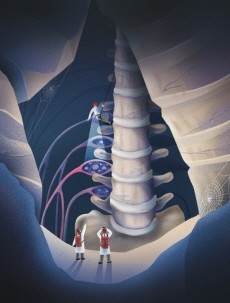
SAN FRANCISCO -- Rubedo Life Sciences, Inc. (Rubedo), an AI-driven, clinical-stage biotech focused on discovering and rapidly developing selective cellular rejuvenation medicines targeting aging cells, today announced that using open source codes integrated in the company’s broader propriety drug discovery platform, ALEMBIC™, helped to identify senescent neurons in a new study that found senescent neurons drive chronic pain with injury and age.[1] Senescent cells, often called “zombie” cells, arise as the results of cellular stress and damage. These senescent cells do not die but undergo cellular changes, including secreting pro-inflammatory factors, thereby potentially contributing to inflammatory responses within the body.[1] The study, led by Stanford University scientists, Vivianne Tawfik, MD, PhD, and Lauren Donovan, PhD, and co-authored by Rubedo team members, including Chief Scientific Officer Marco Quarta, PhD, and Chief Technology Officer Alex Laslavic, was published in the May 14th edition of Nature Neuroscience, a prestigious, peer-reviewed scientific journal, and will be featured on the cover of the May issue.
Image created by Clara Leibenguth for Stanford University; featured on cover of May 2025 issue of Nature Neuroscience.
Image created by Clara Leibenguth for Stanford University; featured on cover of May 2025 issue of Nature Neuroscience.
Dr. Quarta said, “We know that senescent cells, which increase as people age, drive chronic degenerative diseases and conditions. In this study, we were able to show for the first time that neurons can become senescent, fueling neuropathic pain in both mouse models and human dorsal root ganglia tissue. The bioinformatic validation provided as part of our broader ALEMBIC™ platform with SenTeCh™ chemistry technology helped to uncover this link between aging and neuropathic pain, and further corroborates our experimental observations that treatments targeting these senescent cells could offer meaningful benefits for people experiencing age-related conditions.”





 SAN FRANCISCO -- Rubedo Life Sciences, Inc. (Rubedo), an AI-driven, clinical-stage biotech focused on discovering and rapidly developing selective cellular rejuvenation medicines targeting aging cells, today announced that using open source codes integrated in the company’s broader propriety drug discovery platform, ALEMBIC™, helped to identify senescent neurons in a new study that found senescent neurons drive chronic pain with injury and age.[1] Senescent cells, often called “zombie” cells, arise as the results of cellular stress and damage. These senescent cells do not die but undergo cellular changes, including secreting pro-inflammatory factors, thereby potentially contributing to inflammatory responses within the body.[1] The study, led by Stanford University scientists, Vivianne Tawfik, MD, PhD, and Lauren Donovan, PhD, and co-authored by Rubedo team members, including Chief Scientific Officer Marco Quarta, PhD, and Chief Technology Officer Alex Laslavic, was published in the May 14th edition of Nature Neuroscience, a prestigious, peer-reviewed scientific journal, and will be featured on the cover of the May issue.
SAN FRANCISCO -- Rubedo Life Sciences, Inc. (Rubedo), an AI-driven, clinical-stage biotech focused on discovering and rapidly developing selective cellular rejuvenation medicines targeting aging cells, today announced that using open source codes integrated in the company’s broader propriety drug discovery platform, ALEMBIC™, helped to identify senescent neurons in a new study that found senescent neurons drive chronic pain with injury and age.[1] Senescent cells, often called “zombie” cells, arise as the results of cellular stress and damage. These senescent cells do not die but undergo cellular changes, including secreting pro-inflammatory factors, thereby potentially contributing to inflammatory responses within the body.[1] The study, led by Stanford University scientists, Vivianne Tawfik, MD, PhD, and Lauren Donovan, PhD, and co-authored by Rubedo team members, including Chief Scientific Officer Marco Quarta, PhD, and Chief Technology Officer Alex Laslavic, was published in the May 14th edition of Nature Neuroscience, a prestigious, peer-reviewed scientific journal, and will be featured on the cover of the May issue.